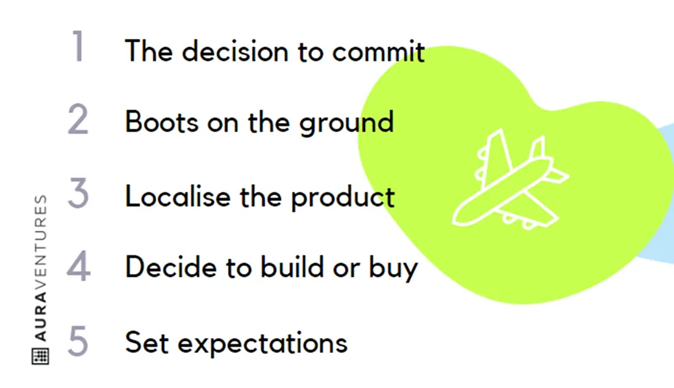Focus on Social Responsibility
Aura is proud to have supported philanthropic partner, Opportunity International Australia, donating c.$35,000 over the last 12 months
There is no doubt that SEA presents an enormous and potentially lucrative opportunity for Founders looking to expand outside of their home markets. Tristan Terry from Aura Ventures shares analysis of the appeal and key considerations for Australian Founders focusing on the market opportunity in Southeast Asia.

Aura Ventures, with the help of our good friends at Stripe, recently held an intimate breakfast for Australian Founders focusing on the market opportunity in Southeast Asia. Eric Chan, Co-Founder of Aura Ventures was joined by the indefatigable Rob Hango-Zada, Co-Founder and Co-CEO of Shippit and Bickey Russell, Head of Startup Partnerships APAC from Stripe — who shared their insights and experiences on the region.
Note: in this piece, when referring to Southeast Asia (SEA), I am including Singapore, Vietnam, Thailand, Malaysia, Indonesia and the Philippines. There are a number of other countries that can be included but all statistics provided are based on the above countries only.
There is no doubt that SEA presents an enormous and potentially lucrative opportunity for Founders looking to expand outside of their home markets. The region’s appeal is a function of its size, growth rate and demographic of its constituents:
In addition to these already very attractive qualities, the region is changing quickly with a number of important trends showing strong momentum:
So, with a prize this big, why is it that Australian Founders don’t go after this region more aggressively? There are obviously several Australian companies that have ventured Northwest and done incredibly well, i.e., Airwallex, Afterpay, and Canva. But it is certainly not common to see the region forming a key part of a company’s expansion strategy (at least at the same rates as you see North America or Europe).
We believe that in a lot of cases, the cultural, social, and political nuances between the countries of SEA can seem too challenging for Australian Founders to navigate. So, while SEA may not be an appropriate region for lots of Australian companies (for various reasons), we believe that at the very least, it should be considered as a possible option for expansion rather than being tossed in the ‘too hard basket’ without thought.
But for those Founders who have been adequately seduced by the regions charms and are looking seriously at how to go about launching their business into one of the most exciting markets on the planet, we (with the help of Rob and Bickey) have compiled a list of the key considerations Founders should be across.

So who’s keen to go to SEA? It’s not quite a cake walk, but certainly an achievable strategy with the right approach, team and supporters behind you. I hope all Founders toying with the idea of expanding into the region find this in some way useful.
Aura Ventures is extremely proud of Shippit (and our other portfolio companies) making things happen in SEA. We are excited to see just how much they can achieve in the years ahead. If you are looking at expanding into the region, please don’t hesitate to reach out to any member of the Aura Ventures team.
Sources: Google, Temasek and Bain e-Conomy SEA 2019, 2020, 2021; Statista for 2022
This information is for accredited, qualified, institutional, wholesale or sophisticated investors only and is provided by Aura Group and related entities and is only for information and general news purposes. It does not constitute an offer or invitation of any sort in any jurisdiction. Moreover, the information in this document will not affect Aura Group’s investment strategy for any funds in any way. The information and opinions in this document have been derived from or reached from sources believed in good faith to be reliable but have not been independently verified. Aura Group makes no guarantee, representation or warranty, express or implied, and accepts no responsibility or liability for the accuracy or completeness of this information. No reliance should be placed on any assumptions, forecasts, projections, estimates or prospects contained within this document. You should not construe any such information or any material, as legal, tax, investment, financial, or other advice. This information is intended for distribution only in those jurisdictions and to those persons where and to whom it may be lawfully distributed. All information is of a general nature and does not address the personal circumstances of any particular individual or entity. The views and opinions expressed in this material are those of the author as of the date indicated and any such views are subject to change at any time based upon market or other conditions. The information may contain certain statements deemed to be forward-looking statements, including statements that address results or developments that Aura expects or anticipates may occur in the future. Any such statements are not guarantees of any future performance and actual results or developments may differ materially from those projected in the forward-looking statements. This information is for the use of only those persons to whom it is given. If you are not the intended recipient, you must not disclose, redistribute or use the information in any way.
Aura Group subsidiaries issuing this information include Aura Group (Singapore) Pte Ltd (Registration No. 201537140R) which is regulated by the Monetary Authority of Singapore as a holder of a Capital Markets Services Licence, and Aura Capital Pty Ltd (ACN 143 700 887) Australian Financial Services Licence 366230 holder in Australia.
Aura is proud to have supported philanthropic partner, Opportunity International Australia, donating c.$35,000 over the last 12 months
The year started with so much opportunity - a new decade and, more importantly, two high-profile exits
Southeast Asia has long been touted as this decade’s land of opportunity for private equity investors looking for growth. And rightly so. The...
Subscribe to News & Insights to stay up to date with all things Aura Group.